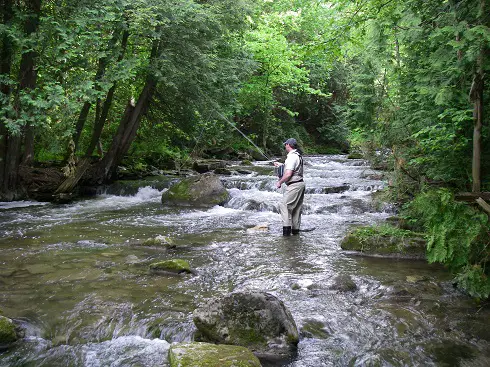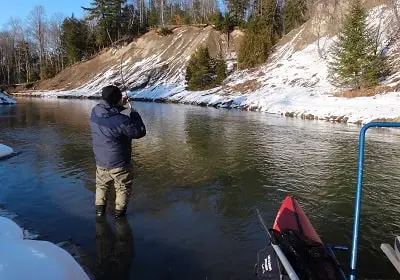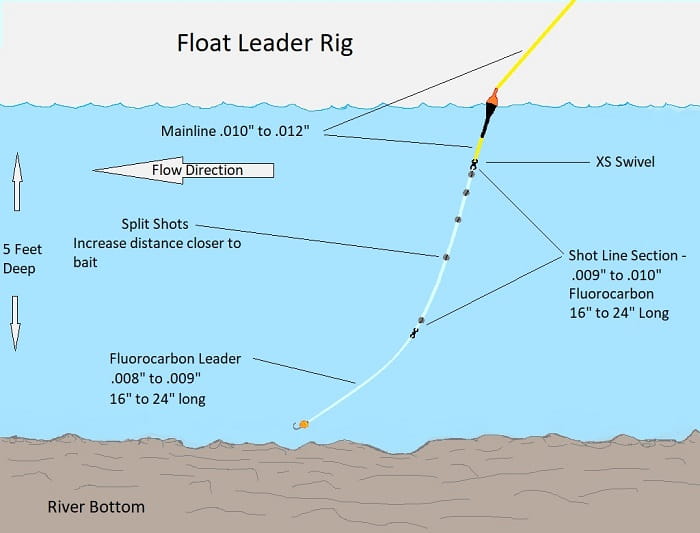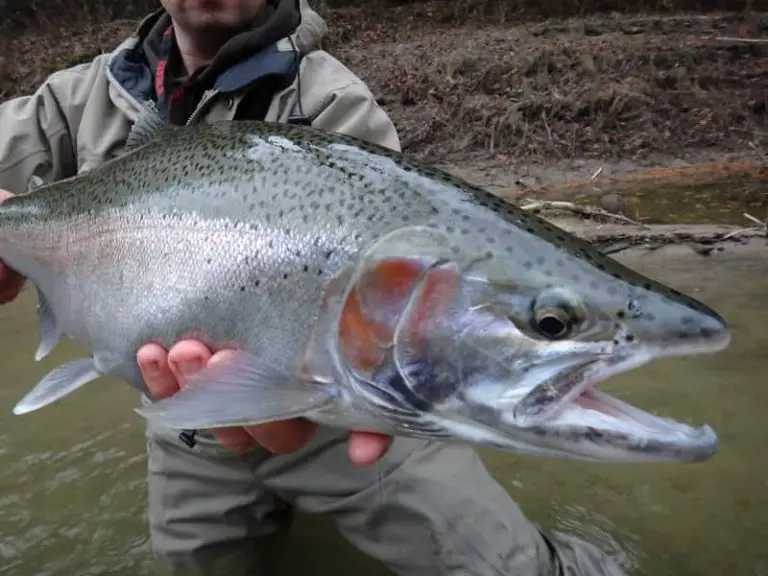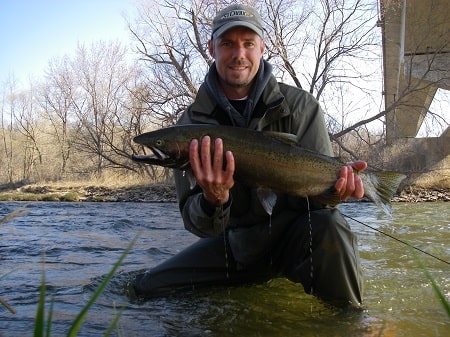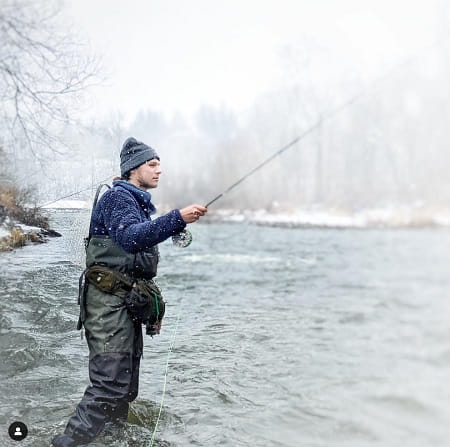Best Centerpin Line: What The Guides Use
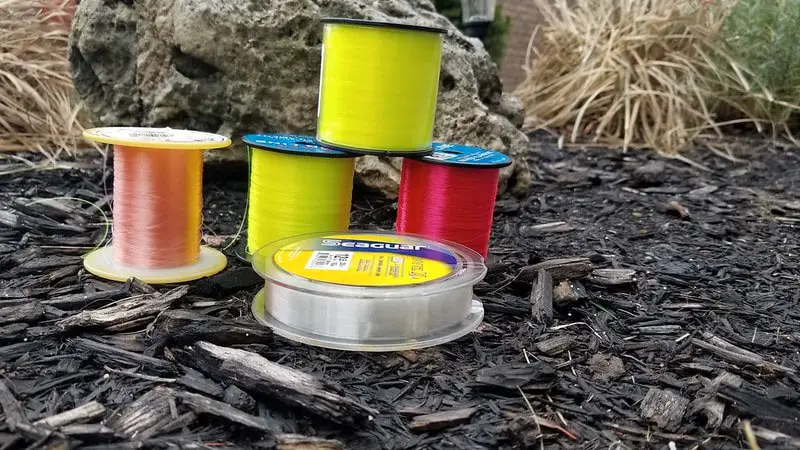
I have been Centerpin fishing for over 30 years and have been a top guide for over 20 years and I will discuss the best Centerpin line, best sizes of line, and best line colors lines for Centerpin fishing. I have seen firsthand what a good Centerpin line can do to help me and my clients catch more fish.
The best Centerpin line is made from monofilament and is thin and light so that it does not sag between the rod tip and the float. Good Centerpin lines must also be strong enough to handle big steelhead, and be buoyant to help you mend it and to improve your hook sets. The best Centerpin line is Raven’s Mainline.
Most lines are made for spin fishing and many are not good for use on a Centerpin reel so use only lines that are proven effective on a Centerpin reel.
After 20 years of guiding and teaching anglers to fish, I have had hundreds of guys come out with their own Centerpin reels already rigged up with the line of their choice, and I have seen how well or how poorly all of these lines work.
Some lines were just so bad it made teaching them how to fish with a Centerpin very difficult and once they switched to my reel and line it was easy to see what a good Centerpin line can do. Even the color of the line can make a difference which I will discuss below.
The Raven Centerpin line is what I use when I’m guiding and it’s what I recommend to my clients and friends but there are a few other lines that I really like to. I will list them all below.
There are many benefits to getting the right Centerpin line and these benefits will improve how well you learn to Centerpin fish, how well you present your bait, and how many fish you will hook.
Use Centerpin Line Made For Centerpin Fishing
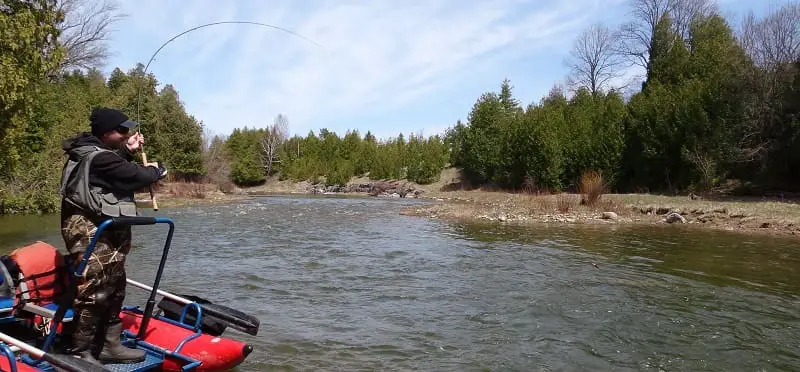
If you think any line will work for Centerpin fishing you are wrong! To me, that is like saying any tire will work on an Indy race car.
Most fishing lines are made for spin fishing reels or baitcasting reels and they are not always good as a Centerpin line.
The Raven Mainline is actually made for Centerpin reels by guys that actually Centerpin fish and know what a good Centerpin line can do for you. Not only that but the Raven Centerpin line has also been tested and proven to be the best Centerpin line by thousands of anglers and it works.
I will also mention a few great alternative Centerpin lines that work really good but just make sure you get the right size line because the size of the line can make a huge difference.
Mono vs Braid vs Fluorocarbon Lines
The best line for Centerpin fishing is a buoyant monofilament line because it tends to be the best general-purpose line with few disadvantages.
Braided lines are a close second because they often float and have little or no stretch which is a benefit when setting the hook from a long distance. The disadvantage to braided lines is that it’s easier to break off on hard hooks sets and during the fight due to no line stretch.
I often need to increase my leader size when anglers come out with braided lines on their reels but increasing leader size can often mean the fish will see it and not bite a bait attached to it.
Another downside to the braided line is their ability to absorb water which can make them sink, but it can also cause them to freeze into a block of ice if you submerge your reel during the winter, or even if the line just gets too saturated.
Never use fluorocarbon as the mainline for your Centerpin reel simply because it is often still and it sinks which is the opposite of what you want a Centerpin line to do.
Centerpin Line Size
The line size is a very important factor for getting a great presentation and it’s something that most anglers often get wrong, and I will tell you why.
I was just out with a client who hired me to teach him how to Centerpin fish for trout and I asked him what pound line he was using on his Centerpin reel. He said 10-pound line because he also fishes for steelhead but I told him that was too heavy.
I told my client that I use 8-pound Raven Mainline for most steelhead rivers around the Great Lakes and I know anglers in his area that even use a 6-pound line because of the benefits that a lighter Centerpin line provides.
My client then mentioned reading on the talk forums that guys were using and recommending Centerpin line up to 17-pound test for steelhead and he asked me why they would go so heavy?
I told him that most anglers buy the line for their Centerpin reel based on the size of the fish that they hope they are going to catch and that they don’t realize that there are other more important factors to consider than the size of the fish.
There are two reasons why I would never use 17-pound line, or even 12-pound line for great lakes steelhead, and a few exceptions.
What most anglers forget is that steelhead are line shy and to get them to bite consistently in some water conditions means that you will often need to use a leader that is 6 pounds or 8 pounds.
Using a leader of only 8 pounds or maybe even 10 pounds means that having a Centerpin line of 17 pounds is useless and since heavy lines are not as good as lighter lines having a line so much heavier than your leader is dumb.
Your Centerpin line only needs to be slightly heavier than your weakest link, and that weak link is the bottom of your leader.
The clearer and slower the water that you fish, the lighter the leader will need to be.
17-pound Centerpin line is good for West Coast Ocean run steelhead but not for most great lakes rivers except for huge fast-flowing rivers like the Niagara River and even on that river, I would likely not go heavier than 14-pound line.
The thing with buying 17-pound line that most anglers don’t understand is that for most line brands, a 17-pound line will break at 20 to 30 pounds. Why use 30-pound line if your weakest link is 10 pounds?
Even using a 10 pound mainline with a 10-pound leader is usually OK because the leader line is usually more true to the breaking strength and a 10 pound mainline will likely break closer to 12 to 18 pounds.
8 pound Raven mainline is a 0.26mm line but the 8-pound leader that I use is only 0.20mm. Even if I was to go up to a 12-pound leader which is about 0.25mm, the 8 pound mainline is still likely still stronger and it won’t break before the leader does so there is no need to go to a 10 pound mainline.
So you see that most lines are not rated properly so you need to be careful of which line you use or you may lose the advantages to the lighter Centerpin lines which I will discuss below.
I will also discuss how to choose the best line for you and the type of water that you fish.
The Advantages Of Lighter Centerpin Line
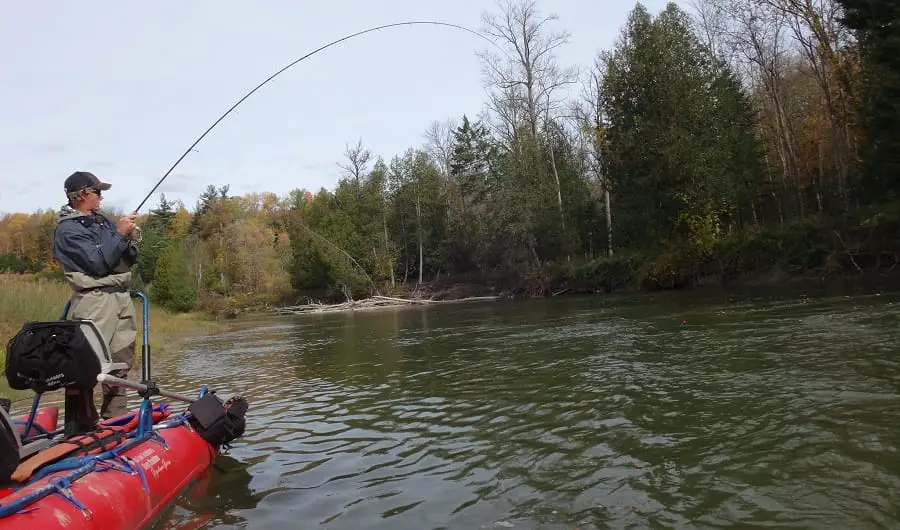
I have been Centerpin fishing for over 20 years all around the great lakes region and I use 8 pounds mainline in every river from New York to Michigan and into Ontario Canada and I have never once wished that I had a 10-pound or 12-pound Centerpin line.
Even when the Salmon River in New York is flowing at 1800 I still managed to land every steelhead I hooked and I almost always caught as many or more fish than other anglers around me.
One of the advantages of a lighter Centerpin line is that the lighter Centerpin line doesn’t sag between the rod tip and the float. Heavy lines will have more of a sag between the rod tip and the float which can hold the float back or tilt your float giving you an inaccurate reading of your float. You will get more sag in slower water and less sag in faster water.
I use the angle of the float to control speeds and help determine depths which is part of what I call my 4 fundamentals of float fishing. Doing this right will greatly increase the amount of fish you hook and you can find out more about that below.
The other thing a light Centerpin line does is that it floats. A floating line is easier to mend should you end up making a far drift that requires your line to be on the water.
Mending allows you to get a better presentation and straighter lines as well as controlling slack line on the water.
Heavier Centerpin lines are more likely to sink and a line under the water will get pulled to the side or down past the float and this will pull the float in unwanted directions when you need to mend it or even while you are drifting the float.
There are some Centerpin lines that are more buoyant even at a heavier pound rating but they will still sag.
A high floating line also improves your hook set. I have watched many guys using their own reel set the hook when it’s at a long distance from us and they have to rip all that sunk line up and out of the water before they get a solid hook set. The floating line on the surface lifts up and sets faster and better.
After seeing hundreds of clients come out with their own Centerpin reels with their own line I have determined that heavy Centerpin lines do not cast as well as lighter Centerpin lines and they do not come off the reel as well.
I have also determined that heavy lines have more memory even on a Centerpin reel and that guys using heavy lines on their Centerpin reels have more line tangles than thinner lines.
Centerpin Line Color
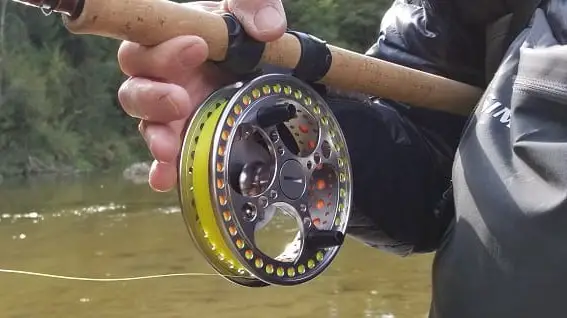
While many Centerpin anglers use clear or green lines there are more advantages to using a brightly colored line.
I use and recommend high-viz yellow lines when I’m fishing and when I am guiding. The advantage to colored lines is that I can see them when I am guiding, my clients can see them and other anglers around us can see them which makes line control better.
Being able to see the line enables you to see things like sag in the line, and to see if the line is up off the water or on the water, and so you can see if the line is dragging sideways or is at a bad angle upriver or downriver of the float.
Other anglers around you can also see the line which enables them to locate your float easier and it prevents them from casting over your line and causing bad tangles.
Some anglers believe that colored lines will be seen by the fish and that will prevent them from biting the line which is mostly false.
If you set up your leader properly the fish will not see the mainline and you can still have all the benefits of a colored line. I only use a colored line when Centerpin fishing with the right leader set up and because of that some years my clients will hook over 500 fish a month.
If the fish seeing the line was an issue and was preventing me and my clients from hooking fish I simply would not use it, but colored lines don’t
How To Choose The Best Centerpin Line For You
When anglers ask me what size Centerpin line to get I tell them you want to get a proven Centerpin line that is 2 pounds heavier than the strongest leader that you use, and your leader will depend on the rivers that you fish and whether you fish for great lakes Steelhead and salmon, or for west coast steelhead and salmon.
The best lines that I have used and what other top Centerpin guides use are:
My adventures to the west coast have shown me that those huge fast-flowing rivers and those extra strong Ocean fish need stronger leaders therefore when Centerpin fishing on the west coast I will use an 18-pound Centerpin line but I would never use that on a great lakes river.
When I’m on my home waters around the Great lakes, the 8-pound Centerpin line has been perfect for me and my clients and almost zero break-offs on the mainline.
The rivers around the great lakes are smaller, clearer, often slower, and you need to use leaders of 6 to 10 pounds in order to get the steelhead to bite consistently. I use 8-pound leaders 90% of the time and I might break off 1 out of every 100 steelhead that I hook. I have also landed steelhead up to 24 pounds on an 8-pound test line.
If the 8-pound test line didn’t work for the average great lakes steelhead of 5 to 8 pounds and even for the bigger ones in the mid or high teens I wouldn’t have my clients use it.
I am so confident in 8-pound Centerpin line that some years in the month of November I will net over 300 wild steelhead for my clients that are between 3 and 15 pounds, and most are on 8 pound Raven Mainline and we rarely break any fish off.
In order for my clients to hook that many steelhead, it’s very important that I am using the right leader size and the right setup.
I have what I call the 4 fundamentals of float fishing and if you know them and use them you could catch 10 times the amount of steelhead you normally catch.
Here is my little rule to help you decide on the right pound line for you.
If you could cast all the way across the river that you fish, an 8-pound Centerpin line should be perfect, especially if you can walk the bank and chase big steelhead if you need to.
If the river you fish is twice as wide as you can cast, say 120 to 200 feet wide, or it’s not possible to walk along the bank to chase a big fish then I would suggest going up to a 10-pound Centerpin line, or even a 12-pound Centerpin line.
Anything heavier than 12 pounds and you start losing the benefits that I discussed above, plus, the line is also going to be way above your leader size.
Having a lighter leader means more bites and I argue with guys that I would rather have 10 fish bite and lose or break off 2 or 3 than having only 2 or 3 fish bite a heavier leader and land all of them.
The simple truth is that the lighter leaders are not seen by the fish and they present your bait better and that always means that more fish will bite your bait.
How to Set Up A Centerpin Reel
Setting up the line the right way, using the right backing, and filling it to the right spot will help you catch more fish.
Now that you know what line to use, I recommend that you check out my page How To Set Up A Centerpin Reel to make sure you do it right. See at www.troutandsteelhead.net
Got A Question About The Best Centerpin Line
If you have a question, comment, or some tips about the best Centerpin line let me know in the comment section below.

